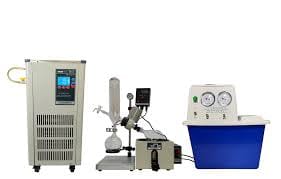Low temperature cooling circulation pumps play a vital role in various industrial and laboratory applications. This article delves into the working principles, key features, and widespread applications of low temperature cooling circulation pumps, while also discussing how selecting the right one can enhance experimental efficiency.
Low temperature cooling circulation pumps are specialized devices designed for environments where precise temperature control is essential. Their primary function is to provide continuous cooling circulation at low temperatures, ensuring the stability and efficiency of chemical experiments and physical processes. In this article, we will explore the working principles, key features, and applications of low temperature cooling circulation pumps, providing practical advice on selecting the ideal model for laboratory settings.

Working Principle of Low Temperature Cooling Circulation Pumps
Low temperature cooling circulation pumps work by circulating a coolant fluid through a closed-loop system, maintaining the desired low temperature in various processes. These systems typically consist of a pump, cooling unit, and a series of hoses or pipes that transport the coolant fluid. The pump circulates the coolant to absorb heat from the source, and the cooling unit ensures that the coolant is constantly chilled to the required temperature.
The pump is usually integrated with temperature sensors and controllers, allowing for precise regulation of temperature within a specific range. As the coolant absorbs heat from the equipment or process, the temperature of the fluid increases. The cooling unit then removes the excess heat, maintaining a consistent low temperature and ensuring optimal conditions for sensitive experiments.
Key Features of Low Temperature Cooling Circulation Pumps
- Temperature Control: One of the most important features of a low temperature cooling circulation pump is its ability to maintain a constant low temperature. With advanced control mechanisms, users can set and maintain precise temperatures, ensuring the accuracy and reliability of experiments.
- High Efficiency: These pumps are designed to operate efficiently, ensuring continuous circulation without excessive energy consumption. Their efficiency helps minimize the overall operational costs in both laboratory and industrial settings.
- Versatility: Low temperature cooling circulation pumps are versatile and can be used in a variety of applications, including chemical synthesis, material testing, and temperature-sensitive processes. Their flexibility makes them essential for diverse laboratory environments.
- Durability: Built with high-quality materials and precision engineering, these pumps are designed for long-term reliability. Whether used in continuous operation or intermittent cycles, they offer consistent performance over time.
- Safety Features: Given the delicate nature of the experiments they support, these pumps are equipped with safety features such as temperature alarms, pressure sensors, and overheat protection, ensuring the protection of both the equipment and the user.
Applications of Low Temperature Cooling Circulation Pumps
Low temperature cooling circulation pumps are utilized in numerous fields where precise temperature control is crucial. Some of the primary applications include:
- Chemical Synthesis: In chemical laboratories, low temperature cooling is often required for reactions that need to be maintained at specific temperatures to ensure the desired outcome. These pumps provide the necessary cooling to maintain these conditions, whether in a batch process or a continuous reaction system.
- Material Testing: Many materials, such as polymers and metals, require specific temperature conditions to test their properties. Low temperature cooling circulation pumps ensure that the testing environment is maintained at the desired temperature, providing accurate results.
- Pharmaceutical Research: In pharmaceutical labs, low temperature cooling circulation pumps are used to maintain the proper conditions for drug development and testing. This is especially important in areas such as crystallization, where precise temperature control is essential.
- Laser Cooling: Lasers are highly sensitive to temperature changes. Low temperature cooling circulation pumps are often used in cooling systems for lasers, ensuring stable performance during experiments and operations.
- Environmental Simulation: Low temperature cooling circulation pumps are also used in environmental simulation chambers, where they help replicate extreme conditions for research purposes. This is vital for testing the durability of materials and systems under various temperature extremes.
How to Choose the Right Low Temperature Cooling Circulation Pump
Selecting the right low temperature cooling circulation pump depends on several factors, including the specific temperature requirements of your process, the flow rate needed, and the nature of the fluid being circulated. For laboratory use, it’s crucial to choose a pump that can provide consistent and reliable temperature control within the required range.
When evaluating different models, consider the following:
- Temperature Range: Ensure that the pump can achieve and maintain the desired temperature range for your specific application.
- Flow Rate: The flow rate should be compatible with the cooling requirements of your process. A higher flow rate can help maintain stable temperatures across larger systems.
- Size and Portability: Depending on the space available in your lab, the size and portability of the pump may be important considerations.
- Energy Efficiency: Look for models that offer efficient energy consumption, which can lead to significant cost savings in the long term.
For example, the AKDW-100L-120 Low Temperature Cooling Circulation Pump is designed to offer reliable cooling performance, suitable for a variety of laboratory and industrial applications. Its efficient design ensures stable temperature control, helping to optimize your processes and experiments.
Low temperature cooling circulation pumps are an essential tool for maintaining optimal temperature conditions in a wide range of industrial and laboratory processes. Their ability to offer precise temperature control, energy efficiency, and reliability makes them invaluable for research and production activities. By understanding the key features and selecting the right model for your needs, you can ensure the success of your experiments and enhance the overall efficiency of your operations. For more detailed insights into low temperature cooling circulation pumps, you can watch a comprehensive video demonstration that explores their applications in greater depth.



